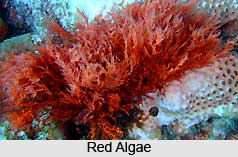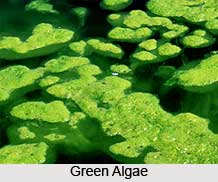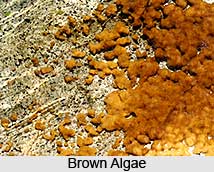 Algae are the simplest of all pigmented plants. They are green, yellow, brown or black in colour and are often found in roadside ponds and puddles, on tree-trunks, rocks and even buildings. Some of them appear brittle, some powdery, some spongy and some tough. The spectrum of colours they splash is due to different types of pigments present in them, such as chlorophyll (green), cartenoid (brown), phycocyanin (blue-green) and phycoerythin (red). With the help of these pigments they manufacture their own food by Photosynthesis. The size of algae shows an enormous range of variation.
Algae are the simplest of all pigmented plants. They are green, yellow, brown or black in colour and are often found in roadside ponds and puddles, on tree-trunks, rocks and even buildings. Some of them appear brittle, some powdery, some spongy and some tough. The spectrum of colours they splash is due to different types of pigments present in them, such as chlorophyll (green), cartenoid (brown), phycocyanin (blue-green) and phycoerythin (red). With the help of these pigments they manufacture their own food by Photosynthesis. The size of algae shows an enormous range of variation.
The simplest among algae is a unicellular form like the Chroococcus which is commonly found as a yellowish brown powdery crust on tree-trunks, rocks and roofs of buildings, too small to be seen individually by the naked eye. At the other extreme are seaweeds like a giant and is 500 m long. There are seaweeds of the genus Sargassum, whose berry-like air vessels enable them to float. Sargassums occur abundantly in the Indian Ocean and in the Bay of Bengal and bits of it are often washed ashore, in winter when the fronds are shed.
 Algae are found almost everywhere where there is water or dampness. They are looked upon as environmental pollutants in places like waterworks and recreational areas and at the same time they are extremely valuable in soils. They occur in a wide range of situations: like in hot springs (60-80øC); in salt-water lakes and seas; and even on snow. They also grow in waters polluted with heavy metals like lead, cadmium and mercury. The legendary red snow in some parts of the Himalaya Mountain and elsewhere is due to the resting spores of the unicellular alga Chlamydomonas. The Red Sea derives its name from the dense growth of the reddish blue-green alga Trichodesmium. This also occurs abundantly in the Arabian Sea. The green tide often observed on the Indian coast is caused by the alga Homellia. Some algae live in association with fungi to form lichens, some grow epiphytically on animals and plants, and some live symbiotically. The red rust of tea and coffee is a typical example of algal parasitism. Algae have also been found in animal intestines and human skulls.
Algae are found almost everywhere where there is water or dampness. They are looked upon as environmental pollutants in places like waterworks and recreational areas and at the same time they are extremely valuable in soils. They occur in a wide range of situations: like in hot springs (60-80øC); in salt-water lakes and seas; and even on snow. They also grow in waters polluted with heavy metals like lead, cadmium and mercury. The legendary red snow in some parts of the Himalaya Mountain and elsewhere is due to the resting spores of the unicellular alga Chlamydomonas. The Red Sea derives its name from the dense growth of the reddish blue-green alga Trichodesmium. This also occurs abundantly in the Arabian Sea. The green tide often observed on the Indian coast is caused by the alga Homellia. Some algae live in association with fungi to form lichens, some grow epiphytically on animals and plants, and some live symbiotically. The red rust of tea and coffee is a typical example of algal parasitism. Algae have also been found in animal intestines and human skulls.
Algae do not produce seeds like the higher plants, but reproduce by a variety of methods like simple division of one cell into two, formation of asexual spores by developing a thick wall around the protoplasm, and also by sexual fusion between male and female sexual bodies (gametes) which are either similar or dissimilar. The simplest type of sexual reproduction is seen in Chlamydomonas where two similar motile cells (gametes) come together, their flagella entwine and the contents of one cell moves into another through a small bridge formed at the contact point of the cells. In some forms the egg cell is formed in special structures called oogonia. In red algae the sexual reproduction is extremely complex.
 Algae are generally classified into 11 groups based largely on their pigment and photosynthetic products and to a lesser extent on their mode of reproduction. The most common type of algae found are blue-green algae, green algae, red algae, brown algae, cryptomonads, dino-flagellates, diatoms, golden-brown algae, yellow-green algae, euglenoids and stoneworts.
Algae are generally classified into 11 groups based largely on their pigment and photosynthetic products and to a lesser extent on their mode of reproduction. The most common type of algae found are blue-green algae, green algae, red algae, brown algae, cryptomonads, dino-flagellates, diatoms, golden-brown algae, yellow-green algae, euglenoids and stoneworts.
Euglena is both plant and animal. Like a plant it has chlorophyll and can make its own food, but it ingests organic material as an amoeba does. Diatoms have a silica wall and form an important constituent of marine and fresh-water plankton. Their fossilized silica frames are characteristic of kieselguhr.
The blue-green algae are the most primitive ones, their fossil history dating back to Precambrian rocks, long before any fossil bones had been found. They resemble bacteria in cell organization with a primitive nucleus but they are photosynthetic in nature.
Green algae are grass-green in colour due to the dominance of the chlorophyll pigment. They are either non-motile, or motile single cells; or colonies formed by groups of cells.
Brown and red algae are marine and commonly called seaweeds. The brown alga or the kelps include the largest seaweeds known. An important representative of this group in the Indian region is Sargassum which provides the raw material for our alginate industries. The Indian coast is also rich in red seaweeds, some of which serve as the raw material for the manufacture of agar-agar, notably Gelidiella and Gracilaria.
Many of these algae are of general economic importance in industry, agriculture, Pharmaceuticals, medicine and cosmetics. Some seaweed form a part of the human diet in many countries, particularly in East Asia, and are systematically cultivated in Japan. Gracilaria meal has been found to be a good supplement to poultry feed in India. Seaweeds also serve as a good source of organic manures, particularly for vegetable crops in coastal areas.
In India there is an annual indigenous production of 35 tonnes of agar-agar and 400 tonnes of alginate. Agar is used in many industries besides being used in laboratories as a solidifying agent for growing microbes. Alginic acid has a variety of industrial applications, in textiles for sizing and printing, in artificial fibres and also as a stabilizing agent in cosmetics and in dairying and dentistry. Diatomaceous earths (kieselguhr) provide abrasives and are also used in making toothpastes, absorbents, filters and insulating material. The nitrogen-fixing blue-green algae are widely used in India as a fertilizer for rice.






































